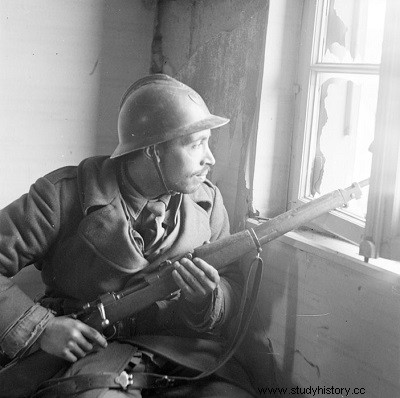
The mission assigned to my group is as follows:
• First, emerge from the Longegoutte ridge, progress on either side of the Moselotte, then, covering up facing Gérardmer, set foot on the ridge road between the Hohneck and the Schweisselwasen;
• In a second step, surge on Guebwiller and the Hartmannswillerkopf. For its part, the 1st D.B., reinforced with Colonel Faure's parachutists, commandos, the Alsace-Lorraine independent brigade (Malraux), the Pommiès franc corps and the 1st Charolais battalion, must cover the southern flank as closely as possible. of my group, first by seizing Thillot, then by going to the Thur valley via the passes of Bussang and Oderen;
• Finally, the 1st D.F.L. will maintain the link with the 1st C.A. towards Champagney and will link its action to that of the 1st D.B. by occupying the balloon of Alsace and descending the valley of the Doller towards Masevaux.
In charge of the main effort with a grouping equivalent to two divisions, I am fully aware of the importance and the difficulty of the mission incumbent on me, but I have complete confidence in the value of the combat tool placed at my disposition. It was first of all my division, the 3rd D.I.A., forged in Algeria the day after the Allied landings in North Africa by General de Monsabert, which gave it its dynamism and its burning offensive spirit. He gave it its cohesion. It was he who led this division from victory to victory in Italy, from Garigliano to Rome and Siena. It was he who, after the landing on the coasts of Provence in mid-August, launched it, in an irresistible dash, on Toulon, where it overran the German resistance while a few battalions, supported by the goums, thrown recklessly on Marseilles, liberate this city, torn from an adversary very superior in number. Finally, it was he who, from Marseille, pushed the 3rd D.I.A. by the circuitous route from the Alps to the Jura where, stopped, out of petrol and ammunition, it nonetheless attempted, with its vanguards, to bar the retreating German troops from access to the Belfort gap.
The 2nd and 3rd G.T.M. are among the four groups that I managed to form in Morocco in hiding after the armistice. I personally know their executives and especially I know the value of these Berber goumiers, authentic descendants of the warriors of Hannibal from whom they inherited the ardor, the rusticity and a total attachment to their leaders. After the rupture of the German Garigliano front, these goumiers were not the spearhead of the Allied offensive on Rome, through the Aurunci and Lepini mountains. The 2nd G.T.M. of Colonel de Latour did not, it is true, take part in the Italian campaign. Detained in Corsica where he had liberated Bastia, he was to be the best craftsman of the
conquest of the island of Elba by General de Lattre. In Provence, the 1st, 2nd and 3rd G.T.M. had brought to the 3rd D.I.A. for the liberation of Marseilles a decisive competition.
What helps to give me confidence in the success of my mission is the commitment, on the right of my group, of the 1st D.B. of General du Vigier, whose units are burning with the desire to emerge victoriously in Alsace. Unfortunately, the Vosges are the most unsuitable terrain for the maneuver of large armored units. All the roads, all the mountain paths leading to the line of the ridges, through the thick Vosges forest, will be hermetically blocked by successive clearings, riddled with mines, beaten by precise fire from artillery, anti-tank weapons and of mortars. To overcome these obstacles, the 1st D.B. will have an elite infantry (paratroopers, zouaves, "shock", African commandos) whose numbers, still insufficient, will be quickly worn out. As for the air force, due to a sky permanently blocked by fog or thick clouds, with only four sunny days in three months, it will be, like the German air force, out of state of enlightening and intervening in the fight. Ultimately, of all the support arms, only the artillery, despite the difficulties of observation in the middle of the forest and in always overcast weather, will provide the most constant and effective assistance to our infantry. She will do this by the precision and the rapidity of the triggering of her shots, but above all by the power of her concentrations to the fullest extent allowed by the shortage of shells. At the most critical hours of the battle, General Besançon, whose A.D. 3 will be frequently reinforced by the value of one or two divisional artillery, will oppose the most violent German counter-attacks with an impassable barrage.
My most serious handicap will be the constant slide towards the north of the American divisions neighbors (3rd, then 36th D.I. U.S.), which threatens to create a vacuum on my left flank.
It is the combination of these various factors, positive and negative, which will determine the course of the operations of my group from October 3 to December 24, 1944, the decisive factor remaining, from beginning to end, the determination of the German command to deny us access to the plain of Alsace by throwing in front of us in the defense and in the counter-attack, all the reserves he may have.
HORSE-LEGERS LANCIERS 1st regiment When he entered Warsaw in December 1806, Napoleon was escorted by a guard of honor made up of Polish nobles whose superb appearance won him over. Also, from March 2, 1807, the Emperor ordered the formation of a pulk, or body of Polish cavalry, of four squadrons int
